City Focus: Angers, The Historic Capital of Anjou
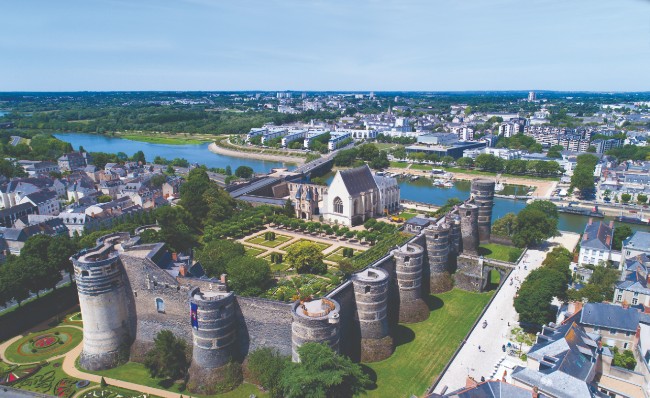
From my lofty vantage point on the broad ramparts of Angers’s medieval fortress, the high points of this attractive city stand proud above the rooftops, an open invitation to explore.
Dominating the Old Town are the soaring twin towers of the cathedral and the bell tower of Saint-Aubin, whilst further out, I can clearly see the huge yellow balloon that marks the Terra Botanica theme park.
There’s plenty more to enjoy in Angers than medieval masonry, but by starting your tour at the castle you can enjoy two of the city’s highlights in one visit.
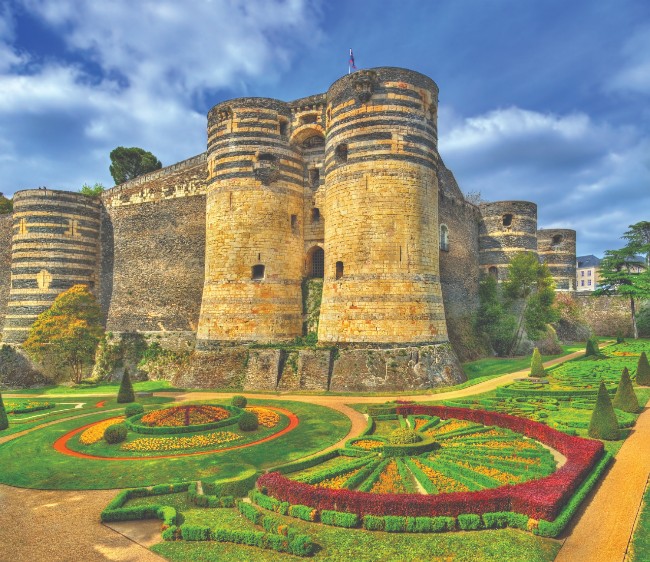
Angers castle. Photo: Shutterstock
Situated close to the confluence of the rivers Loire and Maine – where France’s longest river joins one of its shortest – Angers gave its name to the Anjou region, birthplace of England’s Plantagenet dynasty. The bigwigs here were first counts, then dukes, but never kings of France; although the last Duke, René of Anjou, held the titles of King of Naples and Sicily in the 15th century. When he died without an heir in 1480, Anjou was annexed to France by King Louis XI.
Castles rarely pack a more powerful punch than this one, which dominates the banks of the Maine with 17 towers set into ramparts nearly half a kilometre long. Built from local black schist, it is patterned with white tuffeau stone, familiar from châteaux further east along the Loire Valley. Visit the 15th-century Royal Residence, admire the Angevin vaulting in the castle chapel, and wander through the gardens, both inside the walls and in the moat. Then head up onto the parapet for that sweeping bird’s-eye view.
Angers Castle is also home to the vast Apocalypse Tapestry, the world’s largest medieval tapestry. Commissioned in 1375 by Louis I, Duke of Anjou and brother to King Charles V, it is made entirely of wool and depicts the prophetic visions of St John – the struggle between Good and Evil – as written in the Book of Revelations in 1AD.
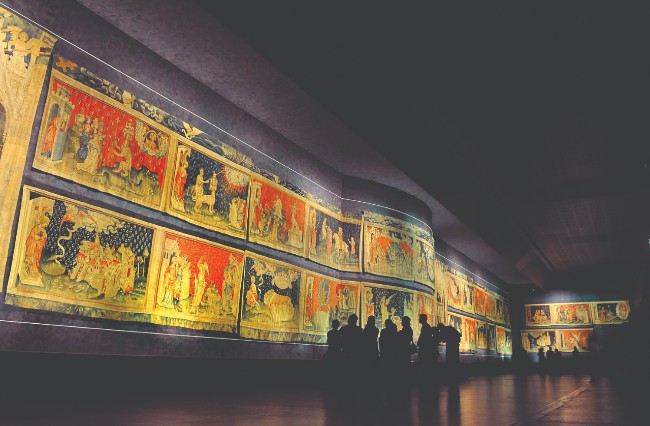
The Apocalypse Tapestry at Angers Castle. Photo: © BOZZARDI
The six huge tapestries are split into detailed scenes, top and bottom, woven on alternating red and blue backgrounds. The workmanship is outstanding, but I find myself equally fascinated by the story. Originally displayed in the courtyard of the Archbishopric of Arles, the tapestry was bequeathed to Angers Cathedral by King René and it hung there until the Revolution. Considered surplus to requirements, the tapestry was offered for sale, but when no buyer came forward, the panels were put into storage before being cut up and distributed piecemeal. Then in the 19th century, a canon from the cathedral set about tracking it down, even finding one piece in use as a saddlecloth. And whilst few parts were found from the sixth panel – perhaps the first to be cut up and given away – a surprising number were recovered and are now displayed in a purpose-built gallery.
The castle and tapestry are both accessible free to holders of an Angers City Pass (24, 48 or 72 hours, from €15), which can be bought from the Tourist Office opposite the château, but be aware that some attractions are closed on Mondays. While you’re there, pick up a map to the self-guided tourist trail through the Old Town and across the Maine; but don’t set off before popping into the nearby Anjou Wines to discover the local vintages – red, white, rosé and sparkling.
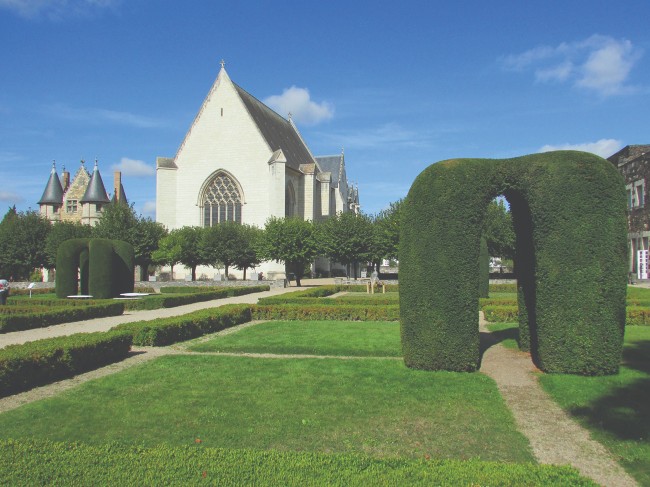
The formal gardens at Angers Castle. Photo: Gillian Thornton
For an atmospheric place to stay in the heart of the Old Town, book one of five rooms at L’Oisellerie, just behind the cathedral. This 16th-century timber-framed property has been beautifully restored by its passionate young owners. Look out for their ground-floor shop selling an array of local products. But do ask for a room on a lower floor if you don’t like stairs!
A CITY OF ART
In the heart of the historic quarter is one my favourite museums in the whole of France, the Galerie David d’Angers, which showcases the work of Pierre-Jean David, who later adopted the name of the town where he had been born in 1788. The son of a wood carver and sculptor, David studied drawing locally before heading to Paris where his fame quickly grew. From 1811 onwards, he regularly sent his studio casts and other works to Angers, as a thank you for the financial support he had received. Further works were donated by David’s family on his death in 1856, and today many of them are displayed in the stunning surroundings of the ruined abbey church. Expect casts of monumental sculptures from public commissions, busts of 19th-century movers and shakers and miniature portraits in medallion format, as well as the plaster model for the pediment of the Panthéon in Paris.
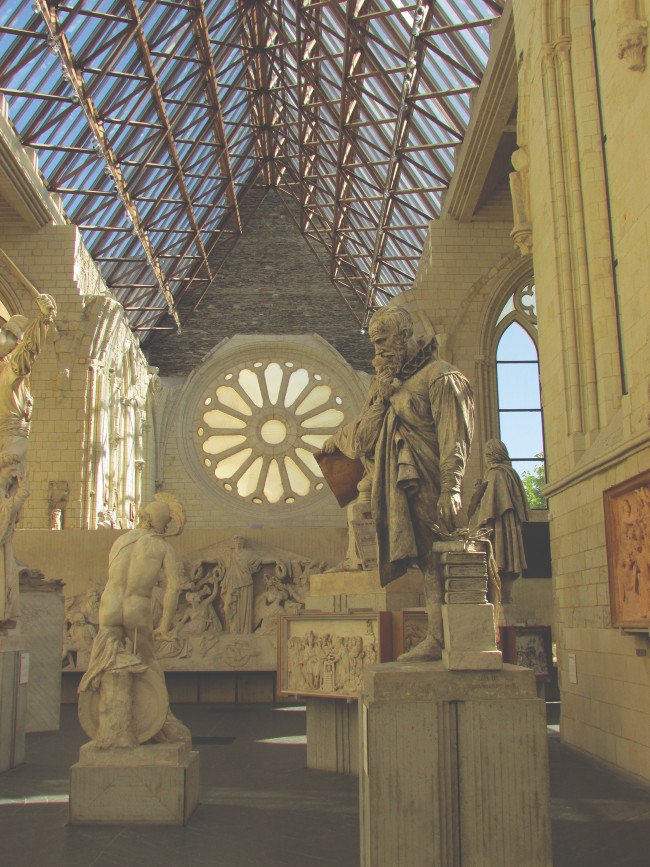
Galerie David d’Angers. Photo: Gillian Thornton
Across the public gardens, there’s more art to be found in the Musée des Beaux-Arts. The museum is housed in the historic Logis Barrault, which was built in the late 15th century for Olivier Barrault, aide to the King and twice mayor of Angers. Highlights include works by artists such as Fragonard, Watteau, Ingres and Jongkind.
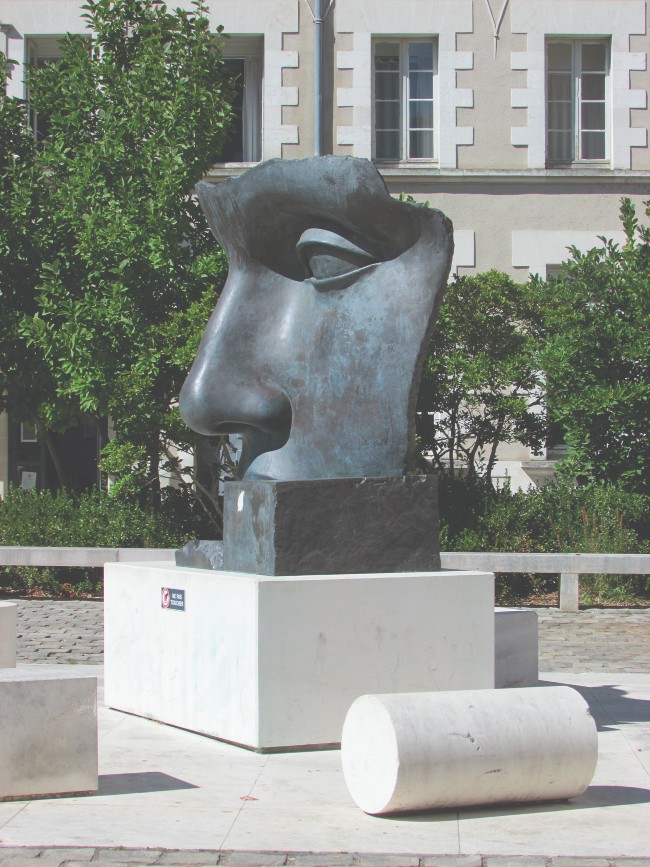
Sculpture outside the Musée des Beaux-Arts. Photo: Gillian Thornton
Then continue your cultural tour by crossing the Maine to the Doutre district – the name of which comes from outre, or beyond – for more artistic surprises at St John’s Hospital. Inside this masterpiece of Plantagenet Gothic architecture, the Musée Jean Lurçat now fills the vaulted space that was once the Great Hall of the Sick. Leader of the French tapestry-making revival, Lurçat’s monumental work, Le Chant du Monde, portrays his vision of the world – destruction and chaos in the first four tapestries; hope and joy in the following six. Prepare to be amazed.
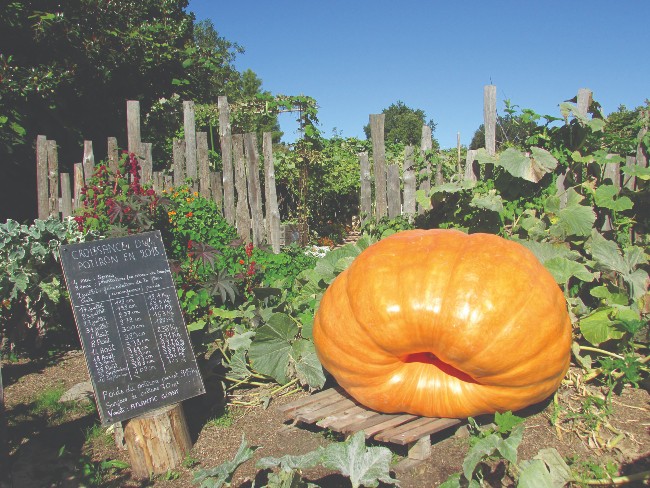
Terra Botanica is a truly unique attraction. Photo: Gillian Thornton
Just 10 minutes by car from the town centre, Terra Botanica is Europe’s only theme park dedicated to plants. Anjou is a big horticultural region, and Angers will host the four-yearly World Horticultural Congress in 2022. I wasn’t sure what to expect at Terra Botanica, but came away thinking you need several hours to do justice to this unique attraction. With its various climate zones, tropical greenhouses and family activities, there really is something here for everyone. Watch a 3D cinema show, take a serene boat ride, and walk through a butterfly house. You can even soar 150 metres up in a tethered balloon to look down on the colourful gardens, the lakes and the glasshouses.
But on my last evening, I went one better – well, a few hundred feet better – with a balloon flight over the Loire with Montgolfières d’Anjou from their base at Gennes. There can be few more serene experiences than floating above the bustle of everyday life, waving at mini-people below, and watching the shadows lengthen as evening falls, and then touching down as the sun slips below the horizon, stowing the balloon, and celebrating at the field edge with a glass of sparkling Anjou. A magical finale to anyone’s city stay.
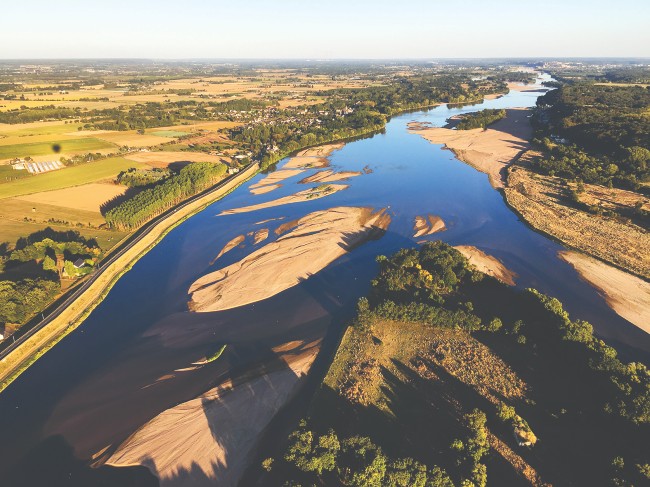
Loire east of Angers as seen from a hot-air balloon. Photo: Gillian Thornton
ANGERS ESSENTIALS
GETTING THERE
BY CAR: Travel from Portsmouth with Brittany Ferries to Caen-Ouistreham (162 miles) or Saint-Malo (125 miles).
BY TRAIN: Angers is 90 minutes from Paris by TGV.
WHERE TO STAY AND EAT: Gillian stayed at L’Oisellerie guesthouse and enjoyed meals at La Réserve, the rooftop restaurant of Théâtre Le Quai, opposite the castle, and the friendly Bistrot des Ducs, 6 rue des deux haies.
TOURIST INFORMATION: www.destination-angers.com
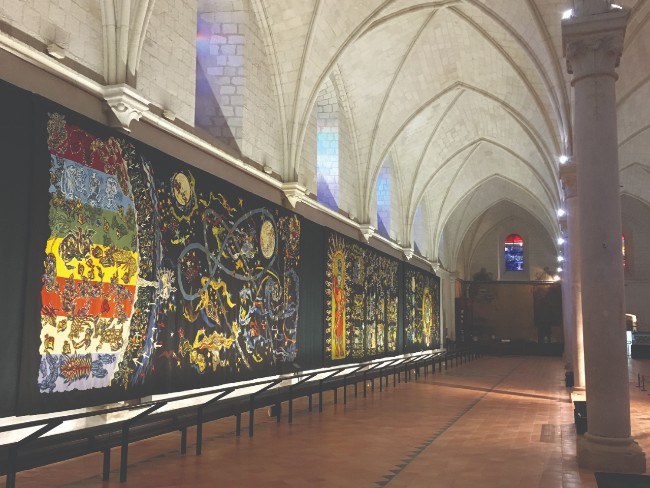
Jean Lurçat Museum. Photo: Gillian Thornton
5 MUST-DO EXPERIENCES IN ANGERS
With a wealth of historic architecture, art galleries, gardens and museums, it can be hard to know where to start in Angers. To cut down on dithering time, kick-start your visit by checking out our top five attractions:
CASTLE AND APOCALYPSE TAPESTRY
The whole rampart walk is now accessible, offering great views over the castle precincts, Old Town and riverbanks. The Monument Café in the castle grounds serves delicious savoury and sweet dishes in verrines (small glass pots). Eat inside the Governor’s lodging or in the garden.
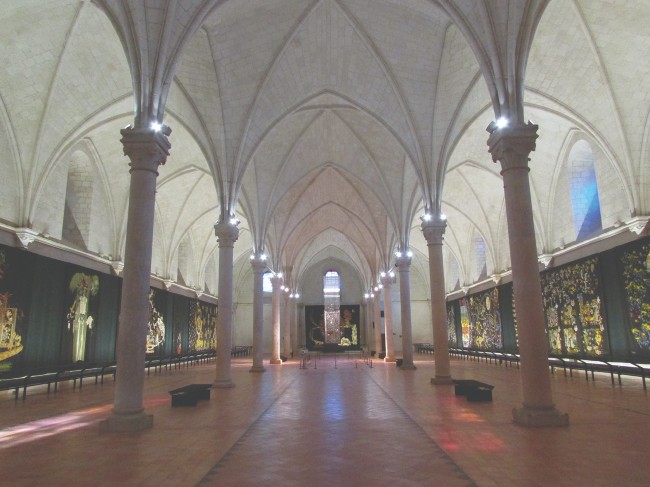
Le Chant du Monde contemporary tapestry. Photo: Gillian Thornton
This enchanting small gallery is stuffed to the rafters with sculptures, busts and friezes of all sizes, as well as studio casts and drawings, all housed in a magnificent 13th-century ‘ruined’ abbey church with a glass roof which illuminates the exhibits to maximum effect.
Stunning contemporary tapestries by Jean Lurçat are displayed at the former St John’s Hospital, founded around 1180 under the instigation of Henry II of England. Check out the tranquil garden, pharmaceutical jars, and the remains of a 17th-century cloister.
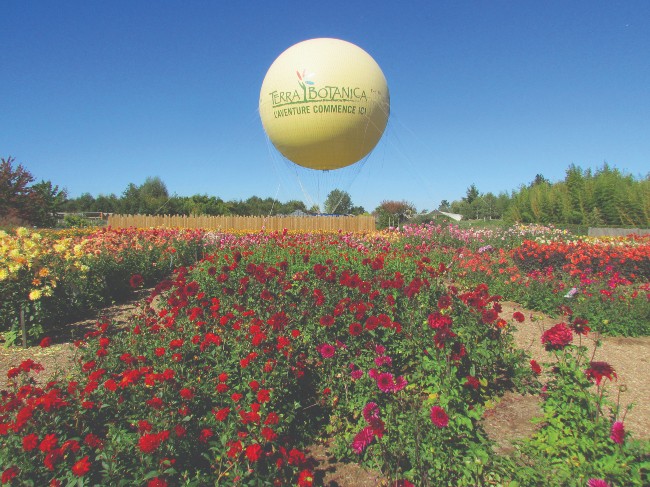
Terra Botanica, the dahlia collection. Photo: Gillian Thornton
Opened in 2010,Terra Botanica is Europe’s only theme park dedicated to plants. With a mix of beautiful gardens and greenhouses, fun activities and educational elements, discover the world through its 275,000 species and exceptional collections of orchids, roses, palm trees and more.
For an unforgettable special treat, head out of town to enjoy a serene flight over the Anjou countryside with Montgolfières d’Anjou. Prices are: Monday to Friday evenings, €200 per person; weekend or public holiday evenings, €230; sunrise, €380.
From France Today magazine
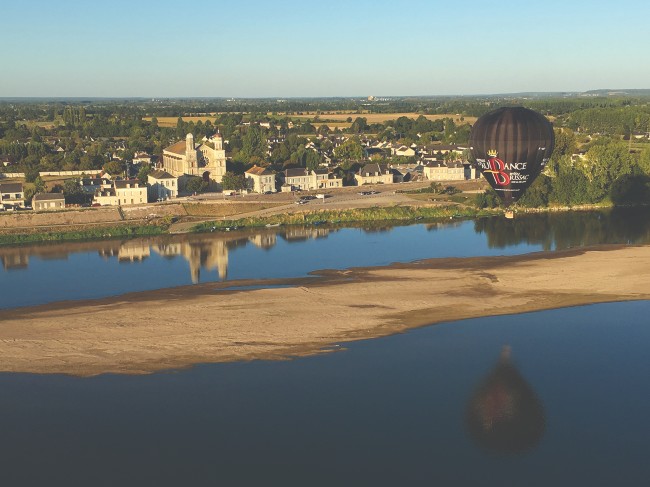
Hot-air balloon over the Loire. Photo: Gillian Thornton
Share to: Facebook Twitter LinkedIn Email
Leave a reply
Your email address will not be published. Required fields are marked *



